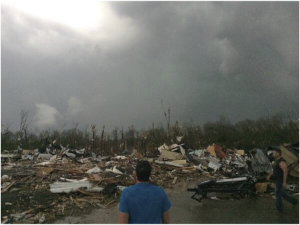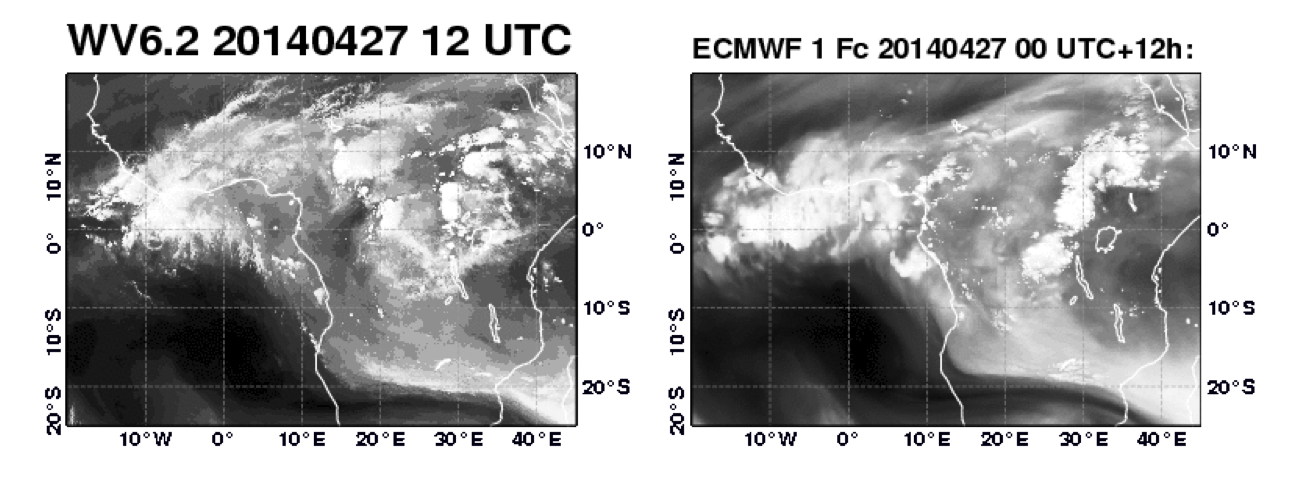Introduction
This page describes two studies of convection exhibiting different characteristics; one over N. America associated with the formation of severe tornadoes, the other over central Africa. The N.America case has strong large scale forcing whereas the central African case is driven by the diurnal cycle. The role of convection in these cases is quite different.
Both cases use a forecast from the same date/time (initial conditions).
In these case studies, you will carry out a control forecast, followed by any number of suggested sensitivity experiments.
These cases were used in the 2014 OpenIFS user workshop at the University of Stockholm.
A Linux 'virtual machine' with a complete copy of the Stockholm workshop exercises is available on request from openifs-support@ecmwf.int.
For more details and copies of handouts, please see the workshop page.
US Tornado convection case (Arkansas)
On the 27 April 7pm local time (00UTC 28 April), tornadoes hit towns north and west of Little Rock, Arkansas killing approx 17 people (see http://edition.cnn.com/2014/04/28/us/severe-weather/index.html?hpt=hp_c2). On the evening on the 28 April fatal tornadoes occurred over Mississippi ( see: http://www.bbc.co.uk/news/world-us-canada-27199071).
This case study will look at the role of convection and the large scale in these events.
More information can also be found on the ECMWF Severe Event Catalogue 201404 - Convection - Arkansas U.S.
African diurnal deep convection (Central Africa)
Over tropical land masses, incoming radiation strongly heats the surface leading to the development of deep convection and precipitation. Observations show that convective activity and precipitation peak in the late afternoon or early evening. Until very recently, numerical weather prediction models struggled to reproduce this diurnal cycle, often predicting convective activity to peak too early in the day. In this case study, aspects of the convective parameterization scheme can be altered to see how the intensity and the diurnal cycle of convection responds.
Note that if using OpenIFS version 38r1 some additional code is needed for the diurnal correction of convection case study.
Please retrieve the modified source code in the file 'src38r1-conv.tgz' from the same directory as the initial conditions as described below.
Initial conditions
Note: The initial conditions data for the case studies described here are available for OpenIFS 40r1. Please contact OpenIFS Support if you require initial experiment data for more recent model version.
Case study initial conditions for this case study are provided on the OpenIFS ftp site.
The initial conditions are available at a range of different resolutions. The experiment ids are created at ECMWF and used for identifying the model forecasts on the ECMWF archive system (for those with access).
All of the initial data provided are derived from ECMWF operational analyses (not ERA-Interim). These operational analyses use a horizontal resolution of T1279 and 137 vertical levels. Lower resolutions are spectrally fitted and interpolated to produce balanced initial conditions.
As OpenIFS is a spectral model, the 'T' number refers to the triangular truncation in spectral space. Equivalent grid resolutions are:
T159 ~ 125km resolution, T255 ~ 80km, T511 ~ 40km, T799 ~ 25km, T1279 ~ 16km.
The number of vertical levels is given after the letter 'L' e.g. L62 means 62 vertical levels.
Please note that higher resolutions progressively require more processors and computer memory to run.
We recommend that the initial files from the 27th April are used for a 30hr forecast for these exercises. The initial files from the 22nd are provided for interest in examining a longer forecast lead-time for the N.American case.
| Resolution | Expt id | Start dates | Filename | File size |
|---|---|---|---|---|
| T159L62 | g4a5 | 2014/04/22 at 00Z | t159l62_g4a5_2014042200.tgz | 19Mb |
| 2014/04/27 at 00Z | t159l62_g4a5_2014042700.tgz | 19Mb | ||
| T255L62 | g4a4 | 2014/04/22 at 00Z | t255l62_g4a4_2014042200.tgz | 51Mb |
| 2014/04/27 at 00Z | t255l62_g4a4_2014042700.tgz | 51Mb | ||
| T255L91 | g455 | 2014/0427 at 00Z | t255l91_g455_2014042700.tgz | 76Mb |
| T511L62 | gflf | 20140422 at 00Z | t511l62_gflf_2014042200.tgz | 190Mb |
| 20140427 at 00Z | t511l62_gflf_2014042700.tgz | 190Mb | ||
| T799L62 | gflg | 20140422 at 00Z | t799l62_gflg_2014042200.tgz | 441Mb |
| 20140427 at 00Z | t799l62_gflg_2014042700.tgz | 441Mb | ||
| T1279L62 | gflh | 20140422 at 00Z | t1279l62_gflh_2014042200.tgz | 1.1Gb |
| 20140427 at 00Z | t1279l62_gflh_2014042700.tgz | 1.1Gb |
To unpack files with .tgz, either use:
tar zxf T159_1999122412_fqar.tgz
or if your tar command does not support compression:
mv T159_1999122412_fqar.tgz T159_1999122412_fqar.tar.gz
gunzip T159_1999122412_fqar.tar.gz
tar xf T159_1999122412_fqar.tar
Download instructions
% mkdir -p runs/convection/t255 % cd runs % ftp ftp.ecmwf.int ftp> cd case_studies/convection_USA_Africa ftp> binary ftp> get t255l62_g4a4_2014042700.tgz ftp> quit % tar zxf t255l62_g4a4_2014042700.tgz % cd 2014042700 % ls ICMCLg4a4INIT ICMGGg4a4INIT ICMGGg4a4INIUA ICMSHg4a4INIT ecmwf % ls ecmwf NODE.001_01.model.1 ifs.start.model.1 namelistfc
Note that the initial conditions unpack into a directory named by the date/time of the forecast start.
The 'ecmwf' directory contains the files produced at ECMWF when this experiment was run:
- namelistfc : copy this file to 'fort.4' to run the experiment (modify as required)
- NODE.001_01.model.1 : this is the model output file as run at ECMWF. If your run fails, it may be useful to compare with this file.
Perform control forecast and analysis
The first step is to run the control forecast. Both cases can be studied with a single 30 hour forecast.
Use the initial files dated 27th April 2014 (filenames include 2014042700) starting at 00Z. Some additional initial files are provided for 22nd April and can be used for the N.America tornado case to investigate the impact of lead time on the forecast.
See below for tasks and key questions to address for the control forecast before moving on to the sensitivity experiments.
We suggest starting with horizontal resolution of T255 for these exercises. Higher resolutions can be used for comparison.
Case study: N.America deep convection
On 27 April 2014 7pm local time (00UTC 28 April), tornadoes hit towns north and west of Little Rock, Arkansas.
Case study: African deep convection
Deep convection develops over central Africa as shown on the water vapour satellite image below, with the accompanying ECMWF forecast shown as a false satellite image. Note that local time for the location in central Africa shown on the map is UTC+2hrs.
Sensitivity experiments
The IFS is highly tuned to give the best forecast over a range of initial conditions. However, it is instructive to try some sensitivity experiments to understand the role of various physical and dynamical processes.
Not all of the suggested experiments are applicable to both cases, indicated in brackets.
- What's the impact of the different 'lead times' on the forecast of the convection (i.e. starting from different dates)? (N.America only)
- What's the impact of resolution on the forecast of the convection? (both)
- Does reducing the model timestep improve or worsen the forecast? (both)
Turn off deep convection (both)
Impact of the improved diurnal cycle of convection. (Africa only)
In this sensitivity experiment, look at the timing of convective and precipitation events by changing how the model parametrizes the diurnal cycle.Increase the precipitation auto conversion rate - what impact does this have? (both)
Impact of the convective time scale adjustment (both)
An optimization factor in the parametrization is used for tuning the diurnal cycle. This can be altered by changing a value in the model namelist.Sensitivity to entrainment rate (both)
Additional questions
- How important is the correct diurnal cycle of precipitation and radiation for 2m temperature and dewpoint forecast?
Further reading
Journal publications
- Bechtold, P. et al, 2014, Representing Equilibrium and Nonequilibrium Convection in Large-Scale Models. J. Atmos. Sci., 71, 734–753. http://journals.ametsoc.org/doi/abs/10.1175/JAS-D-13-0163.1
- Bechtold, P. et al, 2008, Advances in simulating atmospheric variability with the ECMWF model: From synoptic to decadal timescales, QRMS, 134, DOI: 10.1002/qj.289
- Petch, J. C. et al , 2002: The impact of horizontal resolution on the simulations of convective development over land. Quart. J. Roy. Meteor. Soc., 28, 2031–2044. DOI: 10.1256/003590002320603511
Other online material
- See section on convection in description of Atmospheric Physics: http://www.ecmwf.int/en/research/modelling-and-prediction/atmospheric-physics
- More information about the N.American tornadoes can be found on the ECMWF Severe Event Catalogue - 201404 - Convection - Arkansas U.S
- ECMWF training course lecture notes on : Introduction to Moist Processes (PDF), Convection lecture 1 (PDF), Convection lecture 2 (PDF), Convection lecture 3 (PDF)
- IFS documentation, Part IV, Physical Processes - Chapter 6: convection (PDF).
- ECMWF Newsletter, summer 2014, number 140. Article on OpenIFS user workshop 2014 (Stockholm), page 2 (PDF)
Comments
The forecasting system at ECMWF makes use of "ensembles" of forecasts to account for errors in the initial state. In reality, the forecast depends on the initial state in a much more complex way than just the model resolution or starting date. At ECMWF many initial states are created for the same starting time by use of "singular vectors" and "ensemble data assimilation" techniques which change the vertical structure of the initial perturbations.
As further reading and an extension of this case study, research how these methods work.
Acknowledgements
We are especially grateful to Peter Bechtold for suggesting these case studies, assisting in their preparation and for his support during the OpenIFS workshop. We also give a special thanks to: Glenn Carver, Filip Vana and Sandor Kertesz in preparing the material for the OpenIFS user workshop in Stockholm 2014, from which most of the material on this page is derived. We also thank the forecast department for their material on the ECMWF Severe Event Catalogue that was used in preparing these cases. We also thank the participants of the OpenIFS user workshop in Stockholm for their participation and enthusiasm.




